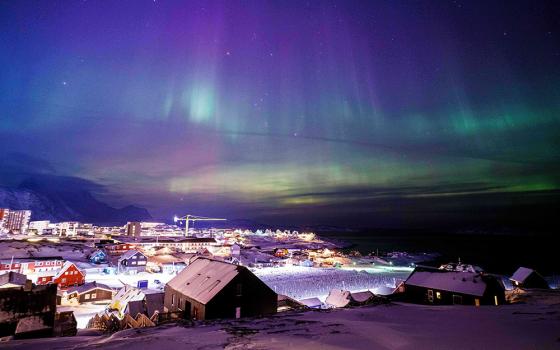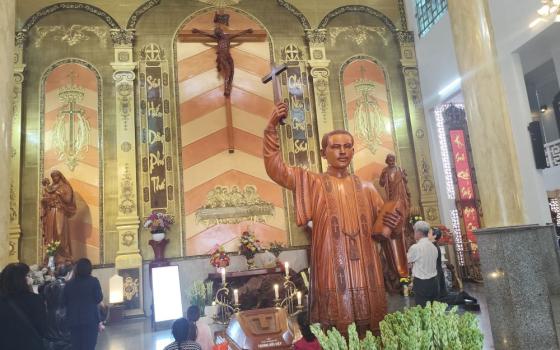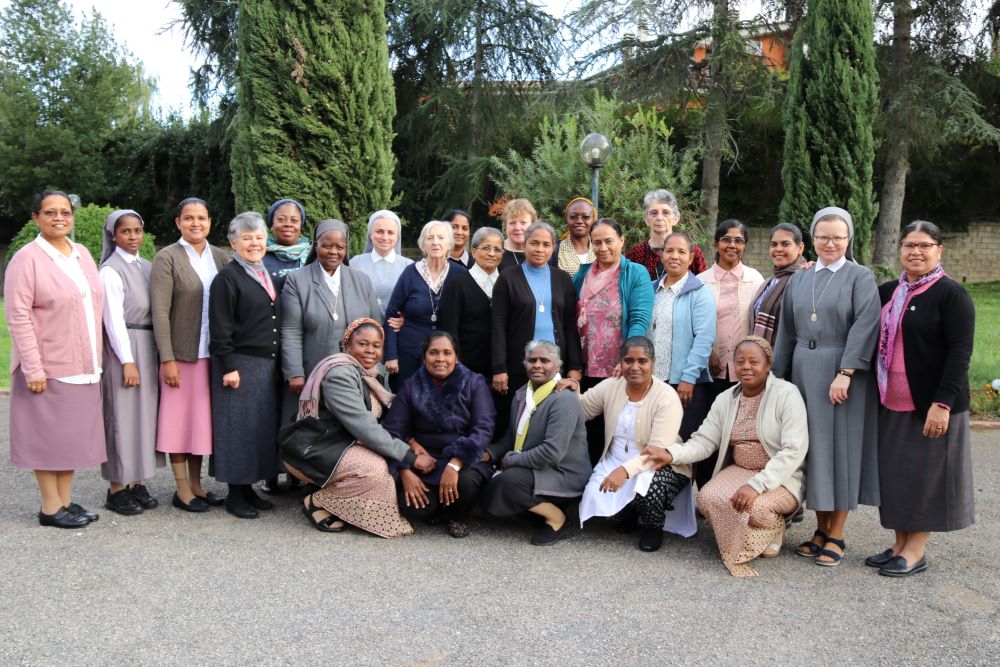
Sisters of Ste. Famille Bordeaux participating in a 10-day program on interculturality pose in Rome in November. Nineteen sisters from across the globe participated in the sessions. (Courtesy of Facebook/Ste. Famille Bordeaux)
An internal group of the Ste. Famille Bordeaux community, created to train missionary sisters within the community in response to the signs of the times, organized a Nov. 10-20 session on interculturality in Rome. The International Interculturality Team is delegated by the general superior, Sr. Ana Maria Alcalde, and founded by the community.
Sr. Maria Rogalska, a Polish nun with the Ste. Famille Bordeaux community in Canada, attended the session and received a blessing from Pope Francis. She was among 19 sisters who attended the formation from different parts of the world.
Rogalska belongs to an intercultural religious community in Montreal, Canada. Intercultural religious communities are characterized by nuns of diverse cultural backgrounds who live together, and share a deep understanding and respect for each other's cultures.
She lives with sisters of diverse backgrounds who share the mission of "promoting communion at all levels in our interconnected world," as explained on their website. The community is inspired by the Holy Family of Jesus, Mary and Joseph.
GSR: Why was there a need for an interculturality session?
Rogalska: Our congregation is an international and missionary congregation. Many sisters have already gone abroad to preach the Gospel, to transmit the charism of the Holy Family and to establish new communities.
The need for this interculturality session was to prepare and form sisters chosen as representatives of their respective communities. These sisters were to pass on the information learned during the session to other sisters who want to become missionaries. I was chosen to represent my community and will be passing on what I learned to the other sisters.
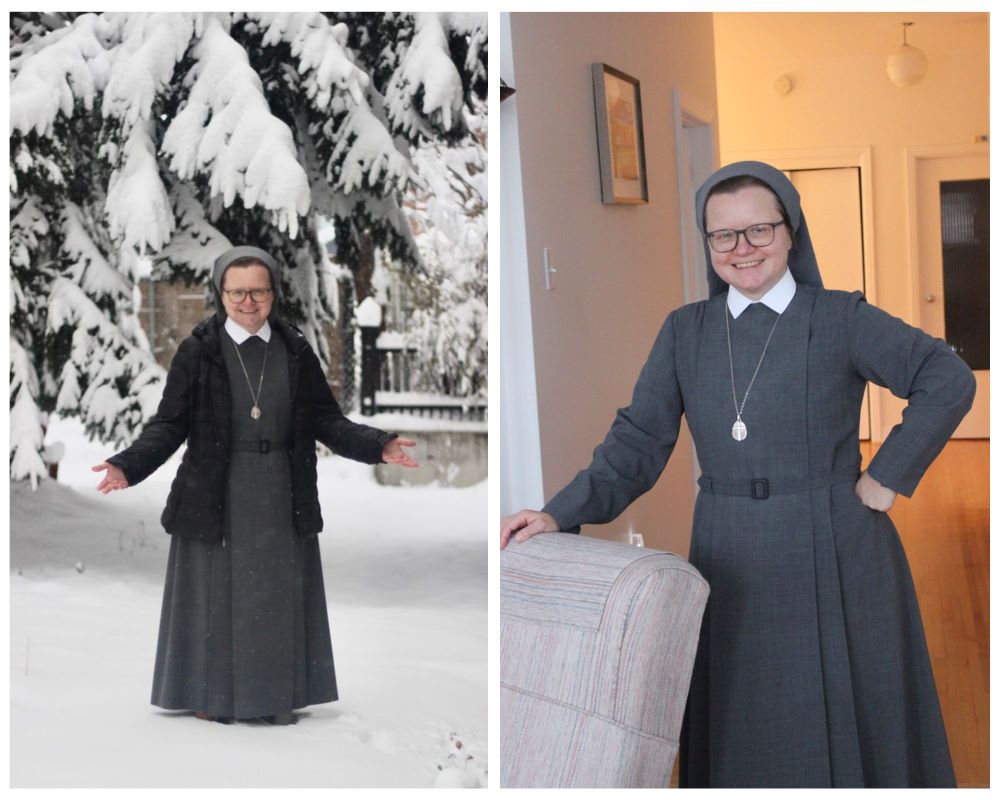
Sr. Maria Rogalska, a Polish nun with the Ste. Famille Bordeaux community in Montreal, Canada, enjoys the outdoors and indoors of life with her intercultural congregation. She lives with sisters of diverse backgrounds who share the mission of "promoting communion at all levels in our interconnected world." (Joanna Kozakiewicz)
There are many sisters who desire to go on missions and leave their own countries, but did not have that opportunity yet. They cannot witness the culture of another country. They can only learn this through the internet or books, but cannot experience living interculturally within their communities. Therefore, there is a need for these kinds of formation sessions to be organized in order for the sisters to prepare and best carry out their mission in any country they could be going to.
For instance, in my community, we are three sisters from three different continents: Asia, Africa and Europe. These are all very different cultures. In the beginning, it was more challenging for us, because we didn't know each other, our cultures or the customs the sisters celebrated in their respective countries. We didn't know any of the customs that sisters celebrate in Congo, Poland or Canada. There is such a need for each sister to be aware of her own culture and that of another sister. Most importantly, what culture we as the sisters of the Holy Family, want to create. What culture do we want to live in? For us, interculturality is the fulfillment of our mission.
I would also like to add that when our founder, Pierre-Bienvenu Noailles, started our congregation, he had a dream. He saw a tree with different kinds of birds that were singing "Glory to God, glory to God alone, and all through Mary." He saw the Holy Family in this great tree, and the birds symbolized diversity. And so every sister is such a bird in this work of God.
The first day of your 10-day session on interculturality began with a "cultural shock." Can you tell us what that looked like?
It consisted of sharing symbols and four characteristics of our respective countries. We had already prepared these earlier in June for our virtual Zoom meeting. I wanted to represent Poland, but there was another sister who represented our country already. However, I got to present the flag of Poland with the white eagle, and Our Lady of Częstochowa. I also presented the flag of Canada and its four characteristics.
Then, based on that first meeting we had in June, we were asked to answer the following questions: What resonates within us? Why do we want to live in an intercultural community? What gives us the pulse to live in our community even though there are difficulties to overcome? Finally, what are the challenges? What are the obstacles to living in an intercultural community in freedom? What are our inner resistances?
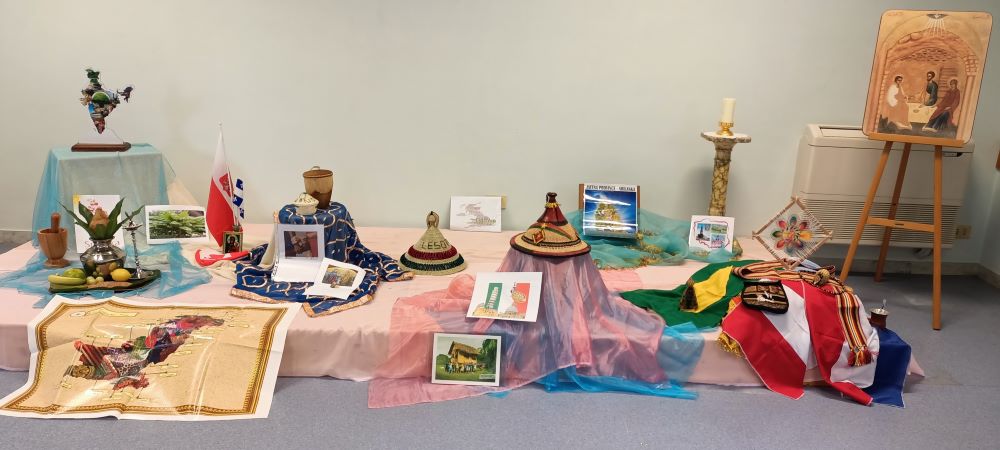
Sisters shared symbols of their respective cultures during a 10-day program on interculturality in Rome. Sr. Maria Rogalska shared the flags of Poland and Canada and Our Lady of Częstochowa. (Courtesy of Facebook/Ste. Famille Bordeaux)
Also, sometimes we may think we know a culture, a country, a flag, from the internet or a book, but in reality, we don't. When I experienced living with sisters from Africa, I learned that in their country, each village had its own culture and its own customs. They have tribes and each of them is different.
For another sister from Sri Lanka a cultural shock was the lack of clothes on women, on billboards or the street, because in her country, women are usually covered.
What did you learn in your session about the four intercultural conflict styles?
We were introduced to the four styles of intercultural conflict resolution according to Mitchell Hammer. The goal was to see which style dominated within us.
The first style that was presented was the discussion style. It uses a direct approach, control of emotions and solves problems with a well-defined process. In this style, it's important to be clear when presenting a position. You say what you mean and mean what you say.
The second style that was presented was the engagement style, which also focuses on direct verbal and non verbal communications. However this style allows for more expression of emotions and listening to the other party. The third style was the accommodation style. This style uses indirect strategies to solve a problem. The goal is to find a way to resolve the conflict in harmony. The use of stories or metaphors to explain a point of view are common in this style. It emphasizes ambiguity and maintaining emotional calm. Finally, the fourth style presented was the dynamic style. It allows for indirect language with strong emotions and third parties as intermediaries.
The sisters from the International Interculturality Team introduced us to these styles and told us what the four types of conflict were. Then they gave us a psychological test to answer and according to which it was calculated which style was more dominant within us.
This test also allowed me to find out to which degree am I capable of living in an intercultural community. Do I listen to others, or do I have the tendency to make my European culture dominant? Do I try to enter into a relationship with others and embrace their diversity?
What skills do you need to develop as a nun to live interculturally?
This was a group activity during which we were presented 11 skills that a nun living in a community should develop.
The following skills were mentioned: awareness, self-confidence, efficiency, open-mindedness in training, willingness to change, relevance of actions, cultivating a learning posture, motivation, tolerance and indulgence, ability to distance oneself, cultivating an ecumenical and collaborative openness.
The sisters had to uncover which one was most needed in their community life. The consensus in our conversations was that we often lacked motivation.
And so, we often have to remind ourselves of our starting point. In other words, what motivated us to begin religious life? This great adventure of life that Christ called us to and said "follow me as you are."
He knows us, he knows our abilities, but he wants to support us living in a community of intercultural religious life so that we can learn even more to live through his abilities and his skills.
Moreover, we can develop certain skills, but we can't really develop motivation. We need to find it in ourselves. We need not to be discouraged in our community life and in our mission towards the outside world, especially when we see a decline in the practicing population. We must go and preach the Gospel to the world, because we are called by Christ to be his disciples and make more disciples.
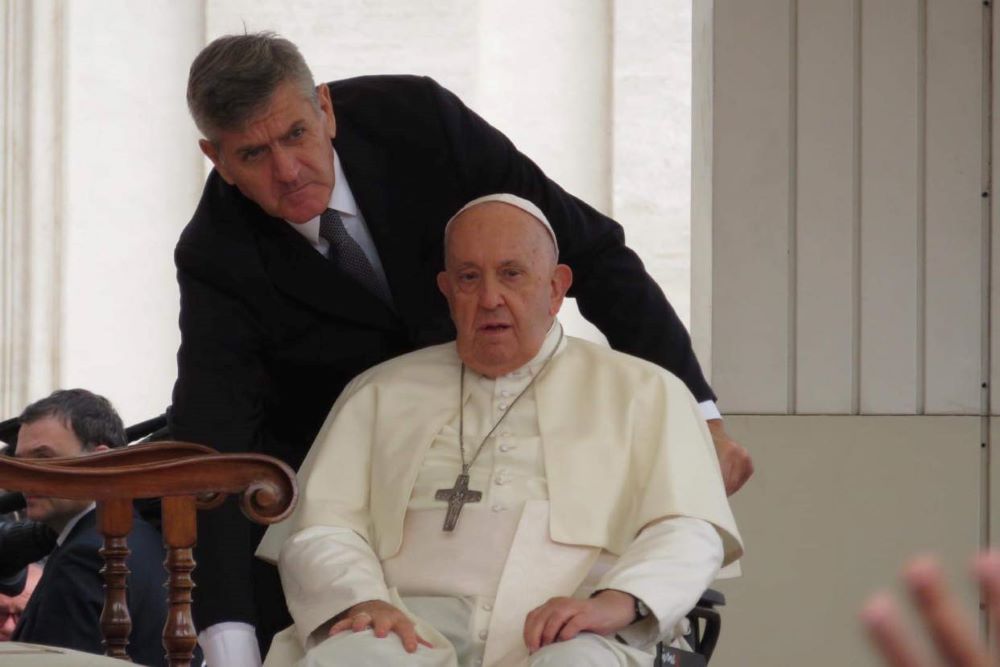
Pope Francis met with members of the Ste. Famille Bordeaux community in Rome for a 10-day program on interculturality during the Nov. 15 general audience. (Courtesy of Maria Rogalska)
How was meeting the pope and receiving his blessing after attending the general audience at the Vatican? Tell us more about that experience.
The sisters of the intercultural team organized for us, as part of our day off, a Wednesday audience at the Vatican with the pope, participating in his catechesis and praying together with the Holy Father. For this audience, we had tickets and were really close to the pope.
I could see the care of the pope who wanted to convey to us the message he had prepared for the day. He read an excerpt from the Gospel of St. Luke, which announced the birth of Jesus Christ as the angels came and sang glory to God and peace to his people.
The audience was in Italian, but the content was translated into other languages. What touched me most was that the pope mentioned his exhortation Evangelii Gaudium and made a point that Christ is the source of our joy. If we are a joyful person, it means that we are a person living with Jesus Christ. And this joy radiates from within us. This was such a blessing for me to hear, because during our 10-day session we focused much on conflicts, our ways of living, what we find difficult in intercultural community life.
But here our attention was redirected towards what brings us joy. The pope reminded us about who is our real source of our life. It is Jesus Christ who gives me the joy of being where I am and doing the tasks he calls me to.
The second thing I noticed was that during prayer time, I could see that the pope was watching the people in front of him, and on the sides of him, as if he wanted to see all the people who were gathered in St. Peter's Square. And each time a person read a passage of the Gospel, the pope blessed them and together with this group said the Our Father and blessed them.
It was so important that the pope blesses all of us for the missions we are called to.
Was this the first time the pope blessed nuns from an intercultural community?
It was the first time for this group attending a formation meeting on interculturality. It was the first meeting with the pope in this group setting. For some sisters, it was the first time being in St. Peter's Square and the first time meeting Pope Francis.
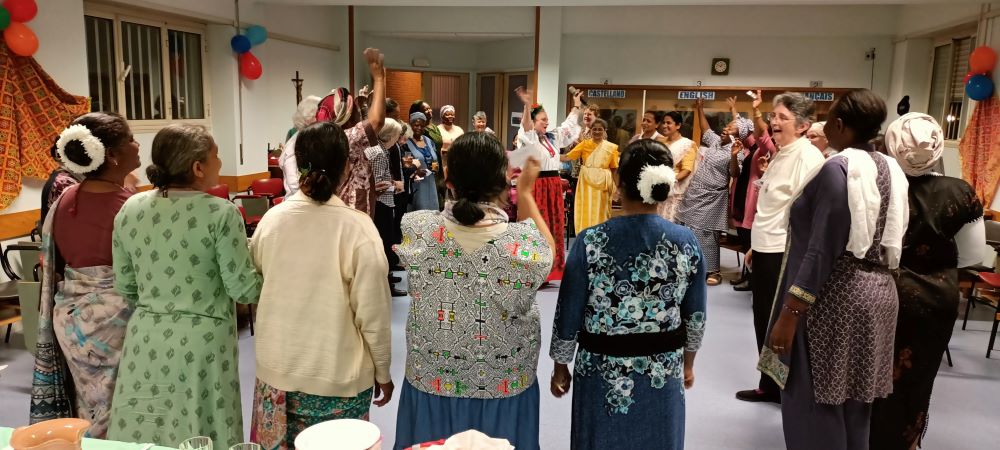
During their 10-day program on interculturality in Rome, sisters Sisters of the Ste. Famille Bordeaux community shared their traditional dress and dances (Courtesy of Facebook/Ste. Famille Bordeaux)
Was this your first time meeting Pope Francis? If yes, what stood out to you?
This was my second meeting with Pope Francis, the first time was at the World Youth Days in Poland, Krakow. He was focused on inspiring the youth to move, get up from their couches and be active.
What stood out to me at this meeting was the different character of it. Here the nature of his teaching and catechesis was directed towards all the people that were present at the general audience. The pope addressed himself in a manner to be understood by all. It didn't matter if you were a religious, a lawyer or a young adult.
What three aspects of the life of Jesus can help understand interculturality?
This was a beautiful teaching that I enjoyed.
The three aspects of the life of Jesus are as follows:
1) The culture of Jesus: Every child is born into a culture. Jesus was born a Jew. He learned to acquire this culture throughout his own life. Although he was God, he learned to walk, to speak and go to the synagogue, he listened to the word of God, he learned just like any of us. Mary and St. Joseph taught him how to behave, how to say sorry, how to say thank you and please.
2) Jesus as a foreigner: As a small child Jesus already had to leave Israel, flee to Egypt and there he had to learn a new culture.
3) Jesus as a foreigner who is rejected by his own people: There was a lack of receptivity towards Jesus when he returned to his own country; he was not accepted by the leaders.
These three aspects can help us identify how important our own culture is and also how we can become foreigners in our own culture.
For those of us who have gone on missions to other countries, it is easier for us to understand being a foreigner. Christ, on the other hand, was a foreigner in his own country.
What is the link between synodality and interculturality?
Our charism is characterized by living in an intercultural community promoting communion at all levels. We want our interculturality to create its own culture, also known as E-culture, which is connected to the culture of the Holy Family. To live our charism truly, we have to do it together, we cannot do it alone.
Synodality also has this goal for us to walk together. Together we can achieve more and go even further.
The three tasks of the synod are communion, participation and mission.
All of this echoes our charism. Communion, meaning oneness. Participation, meaning taking part in something. Mission, realizing what we are called to do.
In synodality, unity and participation is important for us. The final stage of the synod will be our missions, that is, carrying out what we are called to do.
Advertisement
What stood out to you the most from your 10-day session on interculturality in Rome?
Meeting the other sisters from my Holy Family and getting to know them stood out to me the most. Sitting around the table with sisters from around the world, with whom we shared the richness of our lives and our mission.
Through these conversations and time spent together, despite not speaking the same language, we found a way to spend time with each other and how to laugh. But, we also shared some sad moments together. After spending time with the pope at the general audience, we had a cultural evening scheduled in our program. However, that same day we found out one of the sisters from Pakistan received the news that her mother had died. What was touching between us sisters is that we all solidarity decided that for that evening, we would not be having fun at a cultural evening, instead we would be going to the chapel to pray and show our support to this particular sister. Our time of recreation was put on hold, because we didn't know how to rejoice in a moment like this. We couldn't leave this sister alone in her pain. We are a family to her, it was our way to support her and to express our condolences. As for the cultural night, we simply postponed it to another evening.
That cultural evening will also be one to remember, as the sisters presented their cultural dances and outfits. I got the chance to dance Polonez with three other Polish sisters and invited everyone else to join us. I will remember this warmly.
Finally, there was a topic about our vocation that stood out to me. We are called to leave much behind to follow Christ. Leaving our families, friends, everything that constitutes our culture when we leave to another country. Will we be attached to our culture and our country? Or will we be open to a new culture?
What changes will you make in your day-to-day life based on what you learned?
I will try to appreciate even more the value and beauty of another culture, sister, and accept her as she is. Acceptance is what is most important. We spoke a lot about this idea of accepting diversity, which is why our charism exists to begin with.
Now that the session is over we have to live this communion and be transformed by the session. The goal is not just to share the information with the other sisters, but to testify through the way we live our lives in our own intercultural community.




